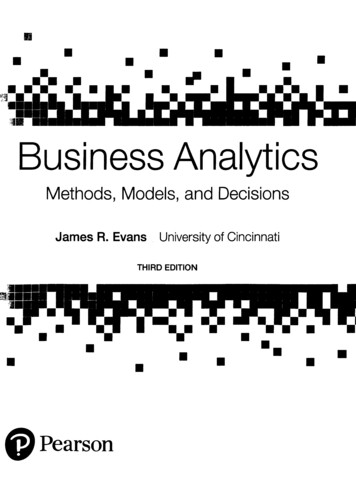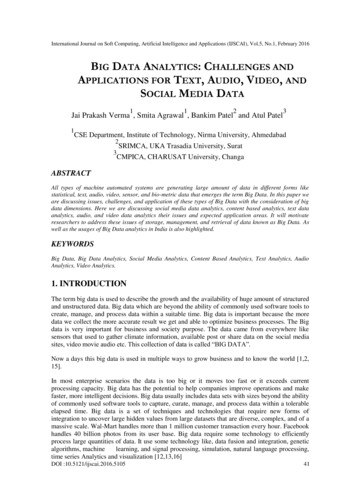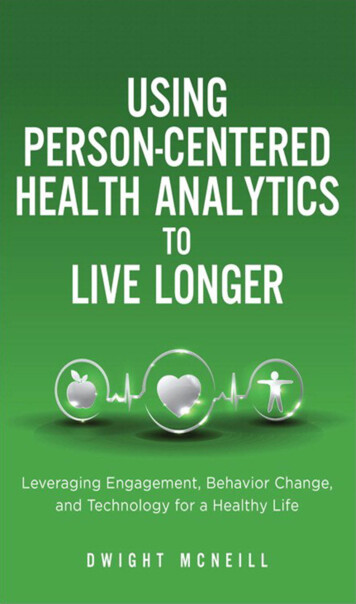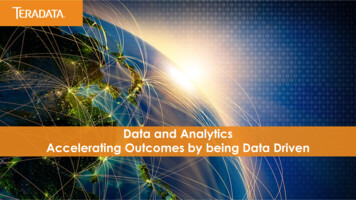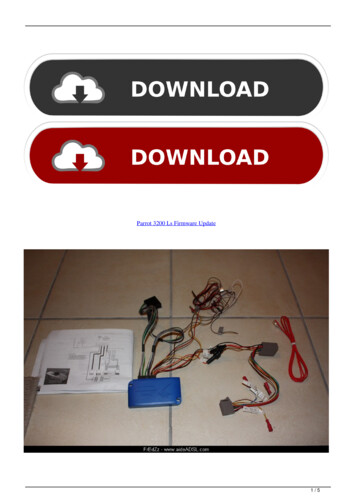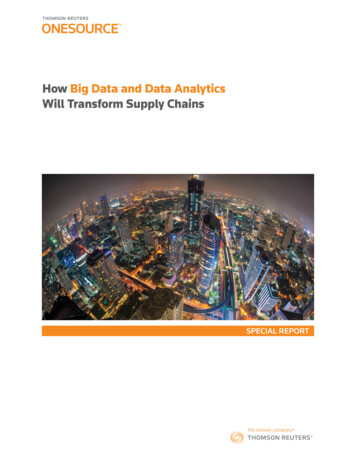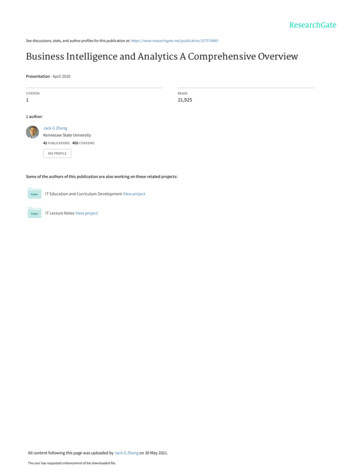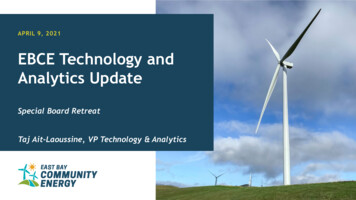
Transcription
APRIL 9, 2021EBCE Technology andAnalytics UpdateSpecial Board RetreatTaj Ait-Laoussine, VP Technology & Analytics
Agenda Team Mission and OverviewThe EBCE Integrated PlatformEnabling a Data-Driven Organization: Use CasesEcosystem of PartnersCustomer Relationship Management (CRM) SystemCCDMS RFPTentative RoadmapCollaboration with Other CCAs2
Team Mission / Meet the Team“Develop an in-house integrated data platform and analyticalcapabilities to conduct ongoing load research and analysis.”- Key Recommendation, EBCE Local Development Business PlanTeam Mission: the Technology and Analytics team manages data, processes andsystems to ensure that EBCE decisions and operations are grounded in data anddriven by analytical insights.3
The EBCE Integrated Data Platform EBCE built its data platform using the Google Cloud Platform (GCP) as a foundation The platform centralizes and processes all data relevant to EBCE Operations With GCP, EBCE staff have access to modern data science and big-data technologies The EBCE platform is unique among CCAs and has contributed to significant innovationWhy Use Cloud Technology?FastCost-EffectiveHighly ScalableSecureModern4
EBCE Manages a Complex Data Environment5
Integrated Data SourcesEnergy Usage Information Hourly/ 15 Minute UsageBills / Billing DeterminantsMonthly Electric UsageGas UsageCustomer InformationOther Data Sources PG&E Customer Details Customer Enrollment Product Choices Tax Assessor RecordsCensus InformationCalEnviroScreenPG&E ArrearsPG&E DisconnectionsPSPS EventsDMV RecordsCAISO Price DataSC DA SchedulesLoad ForecastsPower Procurement TxsGoogle SunroofWeather6
Automated Data IntegrationAd Hoc ReportsCustom ReportsCustom DashboardsDaily transferof source datatriggered byfile or APIevents (newfile added)Data cleansingand loading(ETL) into coreanalyticstablesDailyscheduledexecution ofcoreapplications Refresh of allcore tablesand data setsbased onapplicationoutputLoad ProfilingLoad EstimationLoad AggregationAddress standardizationGeocodingAPI CallsRefresh of coretablessupportingdashboardsand or CRMScheduledoutput filegeneration orAPI callsProgram / Marketing SupportEnrollment ListsTarget ListsMailing ListsSalesforceData Model RefreshModelsRevenue ModelPCIA ModelSQMDShadow SQMD ReportForecastsShort-Term Forecast (Myst)Medium-Term ForecastLong Term Forecasts7
Self Service Dashboards and Reports8
Enabling a Data-Driven Organization Team manages auxiliary systems to facilitate a datadriven organization: Confluence, an interactive wiki-like knowledge repository of all relevantinformation and documentation; Jira, a ticketing system to request ad-hoc analysis or features (100s / year). Recently, 6 EBCE staff graduated from an internal SQLclass to facilitate data querying. We also support additional self-help tools such as QGISto let staff do their own analysis and modeling.9
Use Case: Identifying TOU Transition OutcomesContext:Analysis: Residential customers will soon startdefaulting to a new TOU Rate. Identify eligible customers and use a year ofhourly usage data for all customers. Knowing which customers are winnersand which are losers helps EBCEunderstand the impact of the transitionon revenues, and how to market tothose customers. Calculate billing charges under two scenarios:normal rate, TOU rate. Calculate the cost difference between twoscenarios and identify TOU winners and TOUlosers. Calculate Bill Protection Amount @ Risk. So, who are the winners, and who arethe losers?10
Use Case: Enriching Resilient Home LeadsContext:Process: Customers can submit a form on theEBCE website to see if they qualifyfor the Resilient Home Program. Forms collected on web site are sentto EBCE Analytics team forenrichment Leads need to be qualified andprioritized based on customerprofiles and characteristics. Leads are automatically enrichedwith data from EBCE integratedplatform Implementation partner needs usageand customer details to furtherqualify customers Enriched leads are seamlessly passedon to implementation partner viaGCP.Key Data Elements Added to LeadsCare / Fera / Medical BaselineParcel AgeFire Hazard ZonePSPS Event CountDisadvantaged Community FlagGoogle Sunroof PotentialLow Income FlagHourly Electricity Usage11
Use Case: Preventing Customer DisconnectionsAnalysis:Context: EBCE seeks to proactively help customers thatare at risk of frequent disconnections. Develop a machine-learning model specific to atrisk census tracts. EBCE want to pre-emptively reach out to suchcustomers and focus its resources where mostneeded, to prevent disconnections. Data used: interval kWh, monthly arrearages,monthly gas data, DMV/KBB car values. So how can EBCE predict customers at risk ofdisconnection?EBCE data infrastructure provides platform toingest data, perform computations, and exportcandidates into program campaigns.40%With Model2.5XWithout Model16%Analysis allows EBCE to focus resources on customers most likely to be affected.12
Use Case: Using Data to Respond EffectivelyContext:Analysis: COVID and difficult social circumstances led to asignificant increase in customers with arrears inour service territory. Clean, monitor, analyze and visualize arrearsdata to be used by the Finance and ProgramsTeams. Data from PG&E and partners was difficult touse, interpret and act upon. Data feeds flow into GCP and Salesforce fororganizational decision making. Analysis was required to better understandEBCE’s overall arrears picture. Data allows for data-driven design of programs tohelp with arrears and debt management.13
Use Case: Calculating Revenue “Headroom”Context: Analysis:As a CCA whose rates are tied toPG&E’s, the amount we can spend onenergy (“headroom”) is determined bythe interplay between PG&E rates, PCIArates, and the composition of our load Use hourly forecast usage data for all customers Calculate EBCE rates (PG&E discount /premium) Net out PCIA payments to PG&EYear-to-year changes in PCIA can besignificant, but can also be obscured bystable PG&E generation rates Can also calculate headroom by rate class, city,etc., to help target load reductions to specificcustomer segments but average rates received by EBCE (*net of PCIA*) dropped by14.8%. / MWh / MWhIn January 2021, average rates paid by customers (including PCIA)dropped by 3.4%.GCP Computational power allows us to do this analysis meter-by-meter,and to repeat it in near-real-time under different scenarios.14
Expanding the Ecosystem: Data PartnersMyst is an EBCE partner that generates highly accurate short termload forecasts for EBCE via seamless data exchanges through GCP.15
Pushing the CRM Envelope EBCE has directly licensed its ownCustomer Relationship Management(CRM) system from Salesforce. The CRM is built on the EBCEPlatform, centralizes all customerinformation in one place, andsupports targeting, communicationand enrollment of customer formarketing and local development; The EBCE CRM is the foundation tobringing future functions “in-house”,particularly the call center.16
Call Center and Data Management Services RFP The Analytics team works closely with the EBCE Call Center andData Management Services Provider (currently SMUD). EBCE has issued and RFP to renew these services, due 4/9/2021. RFP seeks pricing and options for call center integration into theservice territory. RFP also calls for tighter integration with EBCE CRM and the EBCERoadmap. RFP was reviewed in detail during the Executive CommitteeMeeting 3/26/2021.17
Tentative Road Map – CRM ActivitiesImplementSalesforce CRMCCDMS CSRsstart using ECRMCRM SupportsEnrollment Forms2021Integrate CRMwith allcommunicationschannels2022CRM has full 360customer viewCentralize alldata in ECRMTransition to ECRMas only system ofrecordImplementcustomer DataAccess Portal20232024Transition CallCenter to ECRM18
Collaboration with Other CCAs Over the last few years, more and more CCAs have embarked on thedevelopment of their own internal integrated platform. EBCE has provided thought leadership in this arena, and has offeredto help other CCAs develop a platform like that at EBCE. EBCE continues to explore ways to partner with other CCAs as itpresents the following advantages: Potential economies of scaleUnified front when dealing with PG&EShared Intellectual Property through Open Source Progress! Most other CCAs are adopting the GCP Platform as thebasis for their own internal systems.19
APPENDIX20
EBCE Modeling LayerSits on top of the Data Warehouse Direct pulls from latest data ensures currency of results But also means that any assumptions / errors made anywhere in the data warehouse flow through (and sometimesaccumulate) in modeling effortsPrimarily self-contained “apps” Shared functions are kept separate in a central “tools” package Models are self-contained analyses Focus on flexibility in development phase pays off later when new questions ariseIntegration with GCP / GCS allows for automatic updates Ability to archive input files / parameters for documentation purposes Increased visibility of results helps to catch errors21
The Analytics team works closely with the EBCE Call Center and Data Management Services Provider (currently SMUD). EBCE has issued and RFP to renew these services, due 4/9/2021. RFP seeks pricing and options for call center integration into the service territory. RFP also calls for tighter integration with EBCE CRM and the EBCE Roadmap.
